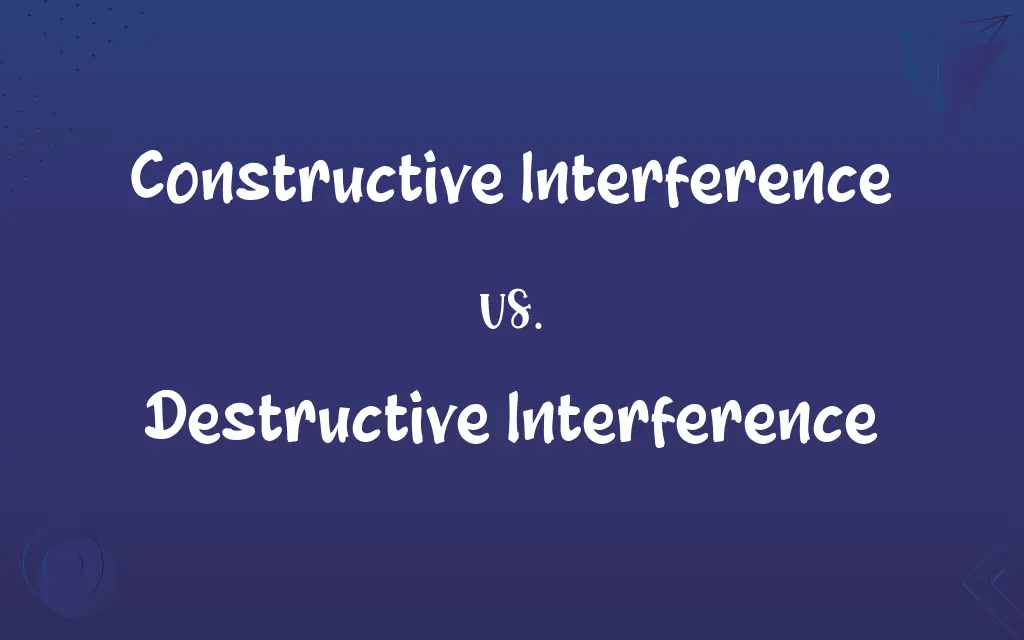Constructive Interference vs. Destructive Interference: Know the Difference

By Shumaila Saeed || Updated on December 25, 2023
Constructive interference occurs when waves combine to increase amplitude, while destructive interference happens when waves combine to decrease or cancel amplitude.

Key Differences
Constructive interference is a phenomenon where waves overlap to create a larger amplitude, resulting in a stronger signal. Destructive interference, in contrast, occurs when waves overlap in such a way that they reduce or cancel each other's amplitude, leading to a weaker or nonexistent signal.
Shumaila Saeed
Dec 23, 2023
In constructive interference, the peaks and troughs of the waves align to reinforce each other. This alignment in destructive interference, however, results in the peak of one wave aligning with the trough of another, causing cancellation or reduction in amplitude.
Shumaila Saeed
Dec 23, 2023
Constructive interference can enhance signals in various applications, like acoustics and radio transmissions. Destructive interference is used to reduce unwanted noise or signals, as seen in noise-cancellation technologies.
Shumaila Saeed
Dec 23, 2023
The conditions for constructive interference include identical or nearly identical frequencies and phase alignment of waves. For destructive interference, it requires opposite phase alignment, where the waves are out of phase by half a wavelength.
Shumaila Saeed
Dec 23, 2023
Examples of constructive interference include amplified sound in concert halls due to overlapping sound waves. Destructive interference is observed in headphones designed to cancel background noise, where sound waves from the environment are neutralized.
Shumaila Saeed
Dec 23, 2023
ADVERTISEMENT
Comparison Chart
Wave Alignment
Peaks and troughs align to reinforce each other
Peak of one wave aligns with trough of another
Shumaila Saeed
Dec 23, 2023
Example Applications
Acoustics, radio signals
Noise-cancellation technologies
Shumaila Saeed
Dec 23, 2023
Observable Effect
Enhanced sound or signal strength
Reduced noise or signal cancellation
Shumaila Saeed
Dec 23, 2023
ADVERTISEMENT
Constructive Interference and Destructive Interference Definitions
Constructive Interference
A phenomenon enhancing wave effects in acoustics and optics.
The constructive interference of sound waves in the tube amplified the sound.
Shumaila Saeed
Dec 12, 2023
Destructive Interference
The merging of waves in a way that decreases their energy.
Destructive interference caused the amplitude of the combined waves to be less than that of the individual waves.
Shumaila Saeed
Dec 12, 2023
Constructive Interference
The merging of waves in a way that increases their energy.
Due to constructive interference, the amplitude of the combined waves was greater than that of the individual waves.
Shumaila Saeed
Dec 12, 2023
Destructive Interference
An interference pattern where waves subtract from each other, reducing intensity.
The destructive interference of light waves created dark fringes in the interference pattern.
Shumaila Saeed
Dec 12, 2023
Constructive Interference
Occurs when waves in phase overlap and reinforce each other.
Constructive interference resulted in a stronger radio signal when the antennas were aligned.
Shumaila Saeed
Dec 12, 2023
ADVERTISEMENT
Destructive Interference
A phenomenon that diminishes wave effects, used in noise cancellation.
The engineers used destructive interference to design a quieter cabin in the aircraft.
Shumaila Saeed
Dec 12, 2023
Constructive Interference
The process where waves combine to make a larger amplitude.
In the auditorium, the sound waves experienced constructive interference, making the music louder.
Shumaila Saeed
Dec 12, 2023
Destructive Interference
Occurs when out-of-phase waves overlap and weaken each other.
The speakers were out of phase, leading to destructive interference and a reduction in sound quality.
Shumaila Saeed
Dec 12, 2023
Constructive Interference
An interference pattern where waves add together, increasing signal strength.
The constructive interference of light waves created bright fringes in the interference pattern.
Shumaila Saeed
Dec 12, 2023
Destructive Interference
The process where waves combine to reduce or cancel amplitude.
Destructive interference in the headphones canceled out the background noise.
Shumaila Saeed
Dec 12, 2023
Repeatedly Asked Queries
Can constructive interference occur with light waves?
Yes, it can enhance the brightness in certain patterns.
Shumaila Saeed
Dec 23, 2023
What is destructive interference?
It's when waves combine in a way that decreases or cancels their amplitude.
Shumaila Saeed
Dec 23, 2023
How is destructive interference used in technology?
Primarily in noise-cancellation devices.
Shumaila Saeed
Dec 23, 2023
What is constructive interference?
It's when waves combine to increase their overall amplitude.
Shumaila Saeed
Dec 23, 2023
Where is constructive interference commonly observed?
In acoustics, optics, and radio signal transmissions.
Shumaila Saeed
Dec 23, 2023
Is constructive interference always beneficial?
Mostly, but it can cause issues like signal interference in communication.
Shumaila Saeed
Dec 23, 2023
Is destructive interference useful in sound engineering?
Yes, especially in creating quiet environments.
Shumaila Saeed
Dec 23, 2023
Do musical instruments use constructive interference?
Yes, to amplify and enhance sound quality.
Shumaila Saeed
Dec 23, 2023
Can destructive interference be used in medical technology?
Yes, in techniques like noise reduction in MRI machines.
Shumaila Saeed
Dec 23, 2023
Can we see these interferences in everyday life?
Yes, in phenomena like amplified sounds or noise reduction.
Shumaila Saeed
Dec 23, 2023
Are both interferences natural phenomena?
Yes, they occur naturally and can be replicated in controlled environments.
Shumaila Saeed
Dec 23, 2023
Do both interferences require specific wave frequencies?
Yes, similar or identical frequencies are needed for both.
Shumaila Saeed
Dec 23, 2023
How do phases of waves affect these interferences?
Constructive interference requires in-phase waves, while destructive interference needs out-of-phase waves.
Shumaila Saeed
Dec 23, 2023
How do waves in a pond demonstrate these interferences?
When waves meet, they can either amplify (constructive) or weaken (destructive) each other.
Shumaila Saeed
Dec 23, 2023
Are these interferences studied in physics?
Yes, they're fundamental concepts in wave physics.
Shumaila Saeed
Dec 23, 2023
How do water waves exhibit these interferences?
Overlapping water waves can show both constructive and destructive patterns.
Shumaila Saeed
Dec 23, 2023
Do engineers use these principles in building design?
Yes, especially in acoustics and signal transmission.
Shumaila Saeed
Dec 23, 2023
Can constructive interference occur in wireless networks?
Yes, potentially leading to stronger signal areas.
Shumaila Saeed
Dec 23, 2023
Can two light waves destructively interfere?
Yes, leading to reduced light intensity or dark fringes.
Shumaila Saeed
Dec 23, 2023
Can destructive interference completely cancel a wave?
Yes, under ideal conditions with perfect phase opposition.
Shumaila Saeed
Dec 23, 2023
Share this page
Link for your blog / website
HTML
Link to share via messenger
About Author
Written by
Shumaila SaeedShumaila Saeed, an expert content creator with 6 years of experience, specializes in distilling complex topics into easily digestible comparisons, shining a light on the nuances that both inform and educate readers with clarity and accuracy.








































































